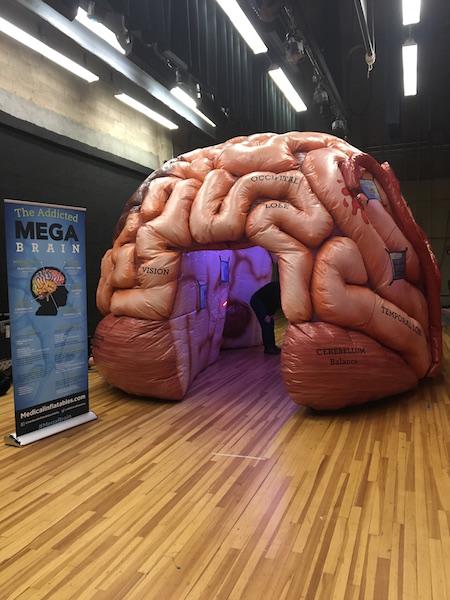A Journey through the Brain at Healthy Teen Brain Day
- Tuesday, 24 April 2018 21:14
- Last Updated: Thursday, 26 April 2018 08:37
- Published: Tuesday, 24 April 2018 21:14
- Emma Townsend/Margaret Smith
- Hits: 4054

On Thursday, April 19th, the Scarsdale Drug and Alcohol Task Force hosted Healthy Teen Brain Day at Scarsdale Middle School. Students from fifth to twelfth grade, as well as parents, were invited.
Entering the hallway leading to the auditorium, I saw a sign leading to an “Escape the Vape Room,”and a table with "foggles," which mimic the effects that alcohol and other drugs have on a person, such as blurred vision. Further down the hall were several more tables, such as a food table and one for the Scarsdale Police Department.
On my way to the stage, there was a table with "Brain Teasers,”including a wordsearch and a maze where I had to find my way through the creases of the brain. Next to the Brain Teasers I found "stress brains," which are similar to stress balls–only in the shape of a brain.
On the stage in the auditorium there was a towering inflatable brain with a tunnel where I walked from the "back" to the "front" of the brain. The back has parts of the brain labeled, such as the temporal lobe, occipital lobe, and cerebellum, while the frontal lobe was labeled on the opposite end of the tunnel. Within the tunnel were diagrams and blurbs about various drugs, such as opioids, as well as information about plasticity, myelin, and Parkinson's disease, or PD. Abuse of opioids like Oxycodone impacts a person's ability to control their emotions and can eventually inhibit the flow of oxygen to the brain. PD, which impedes movement, is more likely to present itself in those who use methamphetamine, as the drug damages dopamine receptors. This damage was demonstrated by a flashing-light visual representation comparing the receptor cells of a healthy patient to those of a patient with PD.
On the exterior of the brain were similar posters, such as one that explained that alcohol affects the front of the brain first and that other parts of the brain are impacted as alcohol consumption progresses. After a certain point, a chronic alcoholic may develop Wernicke-Korsakoff Syndrome, which is a permanent disease that causes psychosis and deprives a person of the ability to create new memories. Another poster shows a diagram of the many parts of the brain compromised by marijuana. The amygdala, for example, is affected and therefore can cause increased anxiety and paranoia.
A docent walked students and parents through the brain, giving in-depth explanations about the different parts of the brain. One particularly interesting fact was that alcohol impacts the front of the brain, which is responsible for emotion, explaining why alcoholics are likely to experience emotional outbursts.
A poster on the inflatable brain showed what to do if someone is having a stroke: Act FAST. If a person has symptoms pertaining to the face (‘F’), arms (‘A’), or speech (‘S’), call 9-1-1 in as little time (‘T’) as possible. Not only is this information useful,
but giving students access to such interactive presentations may also encourage them to become more invested in learning about the impacts of drugs on the brain, rather than having students be lectured by a teacher. Students may be more inclined to attend events like Healthy Teen Brain Day if the events are accessible more often throughout the year. As more students go, other students may be more likely to follow in their footsteps, feeling less embarrassed about something there is no shame in doing: ensuring that they are taking care of themselves, both mentally and physically.
If students have the opportunity to learn in-depth about how drugs operate on the human body, rather than hearing about the effects by word of mouth, they might be more likely to think twice when they are offered a drug at a party. Having this knowledge can transform a person’s perspective on the dangers of drugs from a half-informed hypothesis to an educated, thought-out stance. Margaret Smith and Emily Vallario ran Healthy Brain Day: Here is a letter of thanks from them to everyone who participated:
Margaret Smith and Emily Vallario ran Healthy Brain Day: Here is a letter of thanks from them to everyone who participated:
To the Editor: The Scarsdale Drug and Alcohol Task Force (DATF) presented Healthy Teen Brain Day on Thursday, April 19th at Scarsdale Middle School. The program invited 5th through 12th grade students to participate in substance use prevention activities designed to help students more accurately access the risks of using any substances, especially alcohol, marijuana, and nicotine. Parents were also invited to attend and increase their knowledge as well as their comfort and ability to discuss these sensitive issues with their children.
The DATF could not have delivered this intervention without the generous support and collaboration of many sectors in our community. We would like to extend our warmest thanks to the Scarsdale School District and Middle School Principal Meghan Troy, the 7th grade science teachers, and Head Custodian Rob Schweit and his staff for helping develop the program and making the Middle School campus available and set up for its delivery. The event was made possible by White Plains Hospital, the Village of Scarsdale Recreation Department, Maroon and White, the Scarsdale Rotary Club, the Scarsdale Police Department, and Scarsdale Edgemont Family Counseling Service. We acknowledge Mayor Dan Hochvert and the Village trustees and staff for proclaiming April 19th Healthy Teen Brain day in Scarsdale. We also thank the many parent volunteers, led by Sharon Higgins and Sidney Witter, who gave their time and talent to organize the many moving parts, man tables and doors at the event and keep everything running smoothly. Finally, we had wonderful support from our DATF youth members, Bridget Foley, Caroline Higgins, Julia Kawai, and Jack Waxman, who helped run the event and mentor the younger students in attendance
Besides the afterschool program, the DATF also ran an in-school program for all 7th grade students during their science classes. Science teachers in all houses developed a curriculum centering on the adolescent brain, and this was augmented by a formal symposium at the mega brain for each individual science class run by a trained docent.
By any measure, this program was a resounding success. The DATF hosted 285 students and 115 parents during the after school program and covered about 360 7th graders during science classes. Students enthusiastically engaged in the activities, making this prevention intervention an effective and impactful experience that is likely to be well remembered. Both students and faculty provided very positive feedback about the program.
We are so proud of our community for pulling together to create and deliver an impactful prevention program for our youth. This is population health at work! The DATF looks forward to continuing its activities in the community to give our students the best possible environment for growing up safe and healthy. We invite anyone interested in this mission to join us.
Margaret Smith
Chairperson DATF
Emily Vallario
DATF Coordinator










